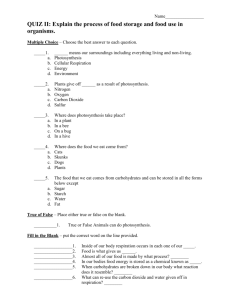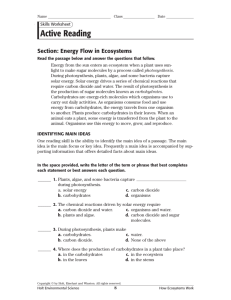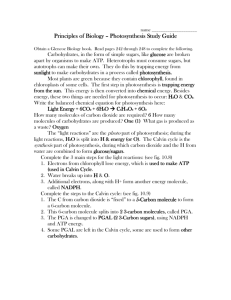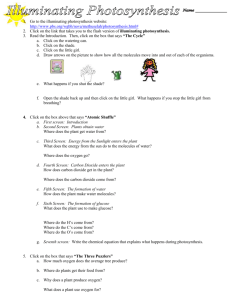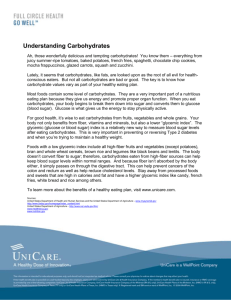5.1_areading
advertisement
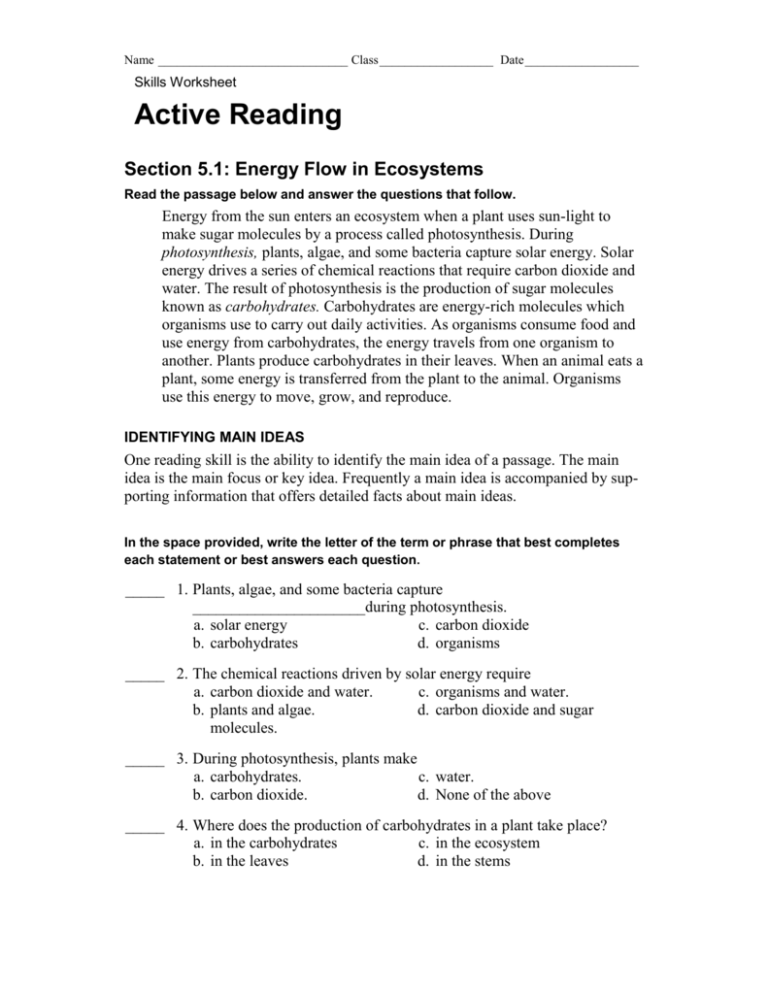
Name ______________________________ Class __________________ Date __________________ Skills Worksheet Active Reading Section 5.1: Energy Flow in Ecosystems Read the passage below and answer the questions that follow. Energy from the sun enters an ecosystem when a plant uses sun-light to make sugar molecules by a process called photosynthesis. During photosynthesis, plants, algae, and some bacteria capture solar energy. Solar energy drives a series of chemical reactions that require carbon dioxide and water. The result of photosynthesis is the production of sugar molecules known as carbohydrates. Carbohydrates are energy-rich molecules which organisms use to carry out daily activities. As organisms consume food and use energy from carbohydrates, the energy travels from one organism to another. Plants produce carbohydrates in their leaves. When an animal eats a plant, some energy is transferred from the plant to the animal. Organisms use this energy to move, grow, and reproduce. IDENTIFYING MAIN IDEAS One reading skill is the ability to identify the main idea of a passage. The main idea is the main focus or key idea. Frequently a main idea is accompanied by supporting information that offers detailed facts about main ideas. In the space provided, write the letter of the term or phrase that best completes each statement or best answers each question. _____ 1. Plants, algae, and some bacteria capture ______________________during photosynthesis. a. solar energy c. carbon dioxide b. carbohydrates d. organisms _____ 2. The chemical reactions driven by solar energy require a. carbon dioxide and water. c. organisms and water. b. plants and algae. d. carbon dioxide and sugar molecules. _____ 3. During photosynthesis, plants make a. carbohydrates. c. water. b. carbon dioxide. d. None of the above _____ 4. Where does the production of carbohydrates in a plant take place? a. in the carbohydrates c. in the ecosystem b. in the leaves d. in the stems Name ______________________________ Class __________________ Date __________________ Active Reading continued VOCABULARY DEVELOPMENT Read each question and write the answer in the space provided. 5. Energy-rich molecules that organisms use to carry out daily activities are. ______________________ 6. The process by which a plant uses sunlight to make sugar molecules is called ______________________ SEQUENCING INFORMATION One reading skill is the ability to sequence information, or to logically place items or events in the order in which they occur. Sequence the statements below to show the steps in the process of energy production and consumption. Write “1” on the line in front of the first step, “2” on the line in front of the second step, and so on. _____ 7. Photosynthesis produces carbohydrates. _____ 8. Plants, algae, and some bacteria capture solar energy. _____ 9. Energy is transferred from one organism to another. _____ 10. Solar energy drives a series of chemical reactions. _____ 11. Other organisms consume carbohydrates found in plants, algae, and some bacteria. RECOGNIZING CAUSE AND EFFECT One reading skill is the ability to recognize cause and effect. In the space provided, write the letter of the effect that best matches the cause. _____ 12. Organisms consume food and use energy from carbohydrates. _____ 13. A plant uses sunlight for photosynthesis. _____ 14. An animal eats a plant. a. Carbohydrates are produced. b. Energy travels from one organism to another. c. Energy from the plant is transferred and used to move, grow, and reproduce.

